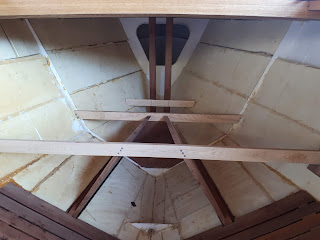All I want for Christmas is my two front berths

The settee berths completed with removable slatted seats. We cut up some foam which we had to see how it would work on the berths; it was too high and too firm, so I found a supplier and will order the foam next year. Businesses are closing for the season soon. But work on the boat carries on. The porthole sizes are finally decided upon and the stainless steel frames are made. Then the frames are used as a cutting template for the rather difficult job of cutting out the portholes. It made the cabin lighter and airier. The shelving units above the settee berths are made in White Ash and fitted. The doors for the units will be made later.










